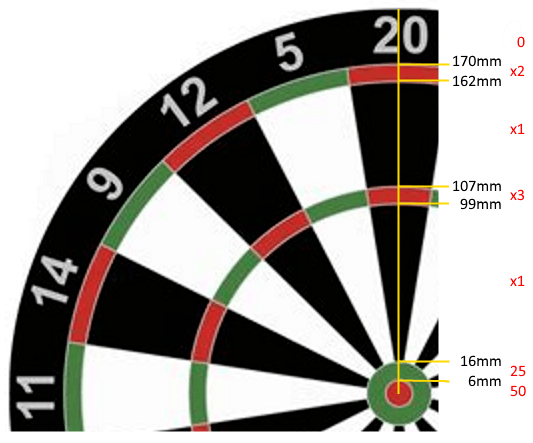22
4
Introduction
Write a program or function that, given the coordinates of where a dart lands on a dartboard, return the score of that dart. Dart coordinates are given as two integers, x,y measured from the center of the dartboard, with millimeter precision.
How to score a dart
Darts is a game played by throwing a dart at a circular board. The dart board is divided into 20 equally sized "wedges". Starting from the top and going clockwise, the sections have values of 20,1,18,4,13,6,10,15,2,17,3,19,7,16,8,11,14,9,12,5. If your dart lands in the black or white parts of any of the wedges, you score the value indicated on the outside of that wedge.
 .
.
However, if your dart lands in the outer green/red ring of the dartboard, you score double the points indicated on the outside of the wedge that you hit. Likewise, hitting the inner green/red ring (the one in between the two white/black sections), you score triple the number indicated on the outside of the wedge. If your dart hits the innermost circle (the red bulls-eye) you instead score 50 points and finally, if your dart hits the second-innermost circle (the green ring around the bulls-eye), you score 25 points.
The dimensions of the rings, measured from the center of the dartboard, are as follows:
Bullseye (50): [0mm-6mm)
25: [6mm-16mm)
Inner Single: [16mm-99mm)
Triple: [99mm-107mm)
Outer Single: [107mm-162mm)
Double: [162mm-170mm)
Miss (0): 170mm+
Note 1: Pictures provided are for illustration purposes only, and are not to scale.
Note 2: Measurements given are approximate, and may not be accurate to a real dartboard.
Note 3: All measurements given are [inclusive-exclusive). For the purposes of this challenge, we're not going to worry about darts hitting the wire and bouncing off. If the dart lands "on the wire" with one of the radial lines, then it is up to the answerer to decide whether to break the tie clockwise or counter-clockwise. Tie breaking direction must be consistent, and indicated.
Note 4: Dartboard is hung in the standard way with the middle of the 20 section being directly above the bullseye, and the 3 section directly below the bullseye.
Input
Two integers representing the x,y coordinates of where the dart landed, measured in millimeters, relative to the center of the dartboard.
Output
A single integer, for the number of points that would be awarded to a dart that landed at the given coordinates.
Sample
0,0 -> 50
2,101 -> 60
-163,-1 -> 22
6,18 -> 1
-6,18 -> 5
45,-169 -> 0
22, 22 -> 4 (if tie-broken clock-wise)
18(if tie-broken counter-clockwise)
-150,0 -> 11
-150,-1 -> 11
Scoring
code-golf. Fewest bytes in your source code wins.

Can you provide a test case where tie breaking is required (a dart hits the wire)? – ovs – 2018-06-25T20:57:59.470
@ovs Gave an example for the radial wires. Should I provide more? Or do we also need examples of the ring wires? Or is that clear how it works now? – mypetlion – 2018-06-25T21:14:49.393
If only we could take input in polar coordinates... – mbomb007 – 2018-06-25T21:19:44.780
I would suggest guaranteeing that the dart will always hit the board. – Shaggy – 2018-06-25T21:35:51.640
1@Shaggy I don't see any decent reason to do so. – Jonathan Allan – 2018-06-25T21:47:24.073
@mbomb007 That was suggested in the sandbox. But that removes probably half the challenge right there. It sounded to me like expecting the input to have part of the challenge done for you. If enough people think it's a better challenge that way, I can change the challenge and come up with some more sample test cases. – mypetlion – 2018-06-25T21:55:29.780
5@Shaggy Can you explain why that should be the case? Personally I would love it if my darts were always guaranteed to hit the dart board, but for the sake of the challenge, I thought it best to stick to reality over fantasy. – mypetlion – 2018-06-25T21:56:26.630
1Suggested test cases:
-150,-1and-150,0which should both give11and may be an edge case on some implementations, as this is the transition between theta converging to -pi and theta = +pi in polar coordinates. (My initial answer failed on the 2nd one.) – Arnauld – 2018-06-26T08:25:18.2201Dangit, x=y=0 is totally messing me up!! Good challenge. – BradC – 2018-06-26T16:22:09.647
1Hope you don't mind, I edited in a better version of the second pic. – BradC – 2018-06-27T15:32:33.437
@BradC Well, I did work really hard on the one I had... No yeah yours does look better. Thanks for the addition. – mypetlion – 2018-06-27T15:58:58.577
1Thank you for accepting my answer. However, this is a code-golf challenge, so you should either accept the shortest answer or no answer at all (the latter being the most common way). – Arnauld – 2018-06-30T08:52:12.667
Can we take input as a complex number? – lirtosiast – 2019-02-05T04:17:06.053
@lirtosiast Sure. As long as it's the equivalent of Cartesian coordinates. Polar coordinates were suggested, but I decided against that. – mypetlion – 2019-02-05T16:57:24.747